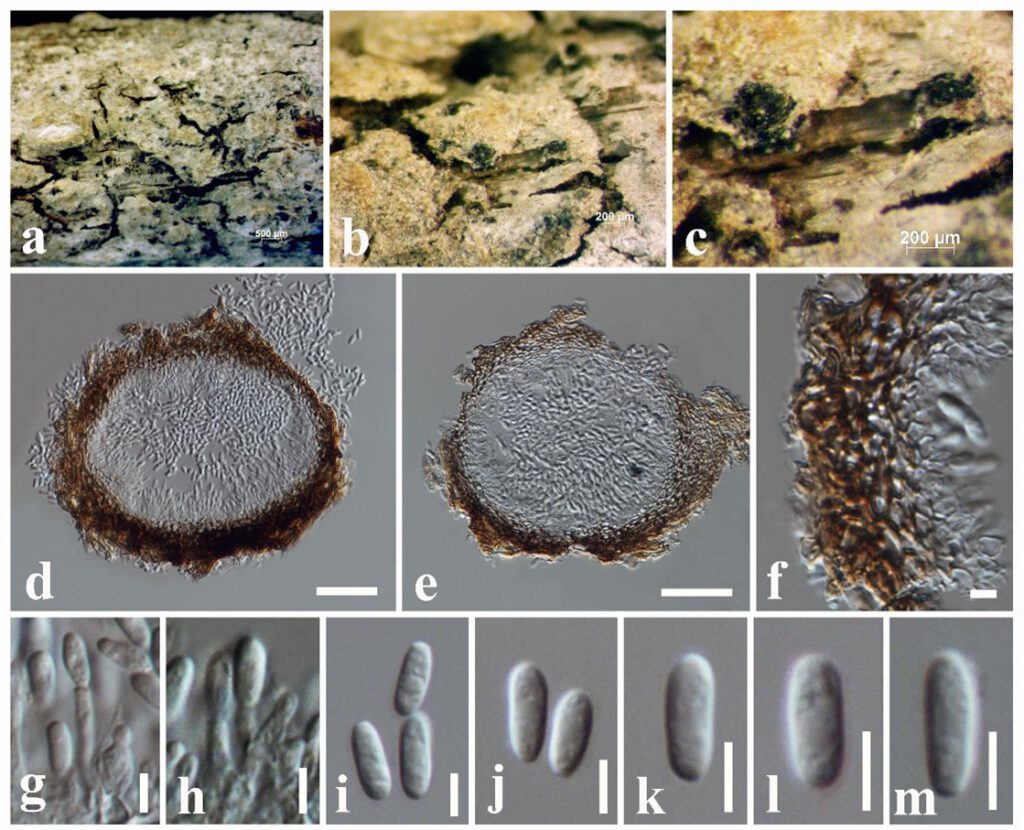Neobambusicola magnoliae N.I. de Silva & S. Lumyong, sp. nov.
MycoBank number: MB; Index Fungorum number: IF; Facesoffungi number: FoF 12710, Fig. *
Etymology: Name reflects the host genus Magnolia, from which the new species was isolated.
Holotype: HKAS 107122
Saprobic on dead twigs attached to Magnolia sp. Sexual morph: Undetermined. Asexual morph: Coelomycetous. Conidiomata 160–200 µm high × 180–230 µm diam., ( = 175 × 190 µm, n = 10), dark brown to black, solitary or scattered, gregarious, unilocular, semi-immersed to immersed, globose to sub-globose. Conidiomatal wall 20–25 μm wide, composed of several layers of small, flattened, thick-walled, brown to dark brown pseudoparenchymatous cells, arranged in a textura angularis, becoming thin-walled and lightly pigmented towards the inside. Conidiophores reduced to conidiogenous cells. Conidiogenous cells 7–12 × 1–3 µm ( = 9 × 2 μm, n = 10), hyaline, phialidic, cylindrical or ampulliform, integrated, hyaline, smooth-walled. Conidia 8–10 × 2–4 μm ( = 9 × 3 μm, n = 40), hyaline, oblong, subcylindrical, with granular content, both ends rounded, thin-walled.
Material examined: Thailand, Chiang Mai Province, dead twigs attached to Magnolia sp. (Magnoliaceae), 6 August 2019, N. I. de Silva, MGT53 (HKAS 107122, holotype).
Notes: Neobambusicola magnoliae groups with the ex-type N. strelitziae (CBS 138869) with 95% ML, 1.00 BYPP statistical support (Fig. 3). Neobambusicola strelitziae was introduced by Crous et al. [54] on leaves of Strelitzia nicolai (Strelitziaceae) from South Africa. They observed two types of conidia, hyaline, fusoid-ellipsoid, 1-septate conidia and hyaline, subglobose to subcylindrical, aseptate microconidia [54]. However, N. magnoliae has one type of conidia. Conidia of N. magnoliae fits well with the microconidia of N. strelitziae in having hyaline, subglobose to subcylindrical, aseptate, granular, smooth and apex obtusely rounded [54]. However, the size of microconidia of N. magnoliae (8–10 × 2–4 μm) is larger than N. strelitziae (3–7 × 3–4 μm) [54]. A pairwise comparison of ITS sequence data between N. magnoliae and N. strelitziae indicates 60 base pair (12.7%) differences across 470 nucleotides. A pairwise comparison of tef1-α was not done as tef1-α sequence data for N. strelitziae was not available in the GenBank. Due to these morphological and phylogenetic variations, we introduce N. magnoliae as novel species.

Figure *. Neobambusicola magnoliae (HKAS 107122, holotype). (b–c) Appearance of conidiomata on substrate. (d, e) Vertical sections through conidiomata. (f) Conidiomatal wall. (g, h) Conidiogenous cells and developing conidia. (i–m) Conidia. Scale bars: (c) = 200 μm, (d, e) = 20 μm, (f–m) = 5 μm.
